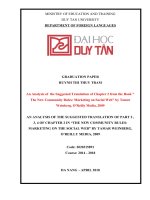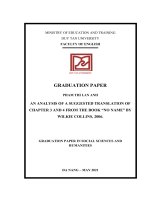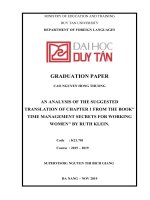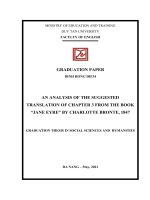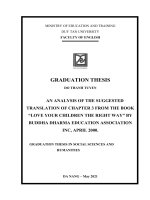An analysis of the suggested translation of chapter 2 from the book facebook marketing leveraging facebook’s features for your marketing campaigns by brain carter and justin levy, 2012
Bạn đang xem bản rút gọn của tài liệu. Xem và tải ngay bản đầy đủ của tài liệu tại đây (998.84 KB, 86 trang )
YEN NGU DUY TAN UNIVERSITY
THI FACULTY OF ENGLISH
THU
Y
AN –
GRA
DUA
TIO
N
PAP
ER
IN
ENG
LIS
H
LIN
STI GUI NGUYEN THI THUY AN
CS -
2022
AN ANALYSIS OF THE SUGGESTED TRANSLATION
OF CHAPTER 2 FROM THE BOOK "FACEBOOK
MARKETING: LEVERAGING FACEBOOK’S FEATURES
FOR YOUR MARKETING CAMPAIGNS" BY BRAIN
CARTER AND JUSTIN LEVY, 2012
GRADUATION PAPER IN ENGLISH LINGUISTICS
DA NANG, 2022
DUY TAN UNIVERSITY
FACULTY OF ENGLISH
Student: Nguyen Thi Thuy An Code: K24NAB2-
24203108619
i
Graduation Paper Supervisor:Nguyen Thi Bich Giang,
MA .
ACKNOWLEDGEMENTS
First of all, I would like to extend my speacial thanks to my supervisor,
Nguyen Thi Bich Giang, M.A, who always enthusiastically helped and guided
me throughout the process of completing my graduation paper. Without her
guidance and useful advice, I probaly would not have been able to complete
this graduation paper.
Secondly, I would like to thank the Faculty of English, Duy Tan
University, the teachers who have provided us with valuable professional
knowledge.
Finally, I would also like to extend my deepest gratitude to all my
friends and my family for their support, understanding and encouragement.
I hopefully get the sympathy of the professors because of the
shortcomings of this thesis.
I wish you all good health and success!
Yours sincerely,
Nguyen Thi Thuy An
Student: Nguyen Thi Thuy An Code: K24NAB2-
24203108619
Graduation Paper Supervisor:Nguyen Thi Bich Giang,
MA .
STATEMENT OF AUTHORSHIP
Up to now, the chapter in this book has not been translated by any 5
I certify that this translation is my work and has not been copied by
anyone else. I used a few references as described in the next section.
All the works used are cited in this end of studies thesis.
Even this graduation thesis was not presented for any research work in
other universities.
Da Nang, March,2022
Nguyen Thi Thuy An
Student: Nguyen Thi Thuy An Code: K24NAB2-
24203108619
Graduation Paper Supervisor:Nguyen Thi Bich Giang,
MA .
ABSTRACT
This aim of this thesis is a suggested translation of part 1, chapter 2
named: “Addressing Privacy Concerns” of the book: “Facebook Marketing:
Leveraging Facebook’s Features for Your Marketing Campaigns, Third
Edition” by Brain Carter and Justin Levy, 2012.
I analyzed almost significant features such as vocabulary, structures in
this work.
In addition, I realized that there are a lot of requirements that students
need to know in order to translate this book correctly.
Student: Nguyen Thi Thuy An Code: K24NAB2-
24203108619
Graduation Paper Supervisor:Nguyen Thi Bich Giang,
MA .
P1/2/3/... : ABBREVIATIONS
SL :
Paragraph 1/2/3/...
TL : source language
target language
Student: Nguyen Thi Thuy An Code: K24NAB2-
24203108619
Graduation Paper Supervisor:Nguyen Thi Bich Giang,
MA .
TABLE OF CONTENTS
ACKNOWLEDGEMENTS.............................................................................i
STATEMENT OF AUTHORSHIP...............................................................ii
ABSTRACT....................................................................................................iii
ABBREVIATIONS........................................................................................iv
TABLE OF CONTENTS................................................................................v
CHAPTER 1. INTRODUCTION..................................................................1
1.1. Rationale:...............................................................................................1
1.2. Aims and Objectives:............................................................................2
1.2.1. Aims:....................................................................................................2
1.2.2. Objectives:...........................................................................................2
1.3. Scope of the Study:................................................................................2
1.3.1. Text Features:.....................................................................................2
1.3.2. Text Length:........................................................................................3
1.3.3. Text Organization:.............................................................................3
1.3.4. Text Sources:.......................................................................................4
CHAPTER 2. THEORETICAL BACKGROUND......................................5
2.1. Definition:..............................................................................................5
2.2. Types of Categories:.............................................................................6
2.2.1. Full vs. Partial Translation:...............................................................6
2.2.1.1. Full translation:........................................................................6
2.2.1.2 Partial translation:....................................................................6
2.2.2. Total vs. Restricted Translation:.......................................................7
2.2.2.1. Total translation:......................................................................7
2.2.2.2. Restricted translation:.............................................................7
Student: Nguyen Thi Thuy An Code: K24NAB2-
24203108619
Graduation Paper Supervisor:Nguyen Thi Bich Giang,
MA .
2.2.3. Phonological Translation:..................................................................7
2.2.4. Graphological Translation:...............................................................8
2.3. Methods and Principles:.......................................................................8
2.3.1. Methods:..............................................................................................8
2.3.1.1. Word-for-word Translation:...................................................8
2.3.1.2. Literal Translation:..................................................................8
2.3.1.3. Faithful Translation:................................................................8
2.3.1.4. Semantic translation:...............................................................9
2.3.1.5. Adaptation:...............................................................................9
2.3.1.6. Free Translation:....................................................................10
2.3.1.7. Idiomatic Translation:...........................................................10
2.3.1.8. Communicative Translation:................................................10
2.3.2. Principles of translation:..................................................................10
2.3.2.1. Meaning:.................................................................................10
2.3.2.2. Form:.......................................................................................11
2.3.2.3. Register:..................................................................................11
2.3.2.4. Idiom:......................................................................................11
2.3.2.5. Style and Clarity:...................................................................11
2.3.2.6. Source Language Influence:..................................................11
2.4. Context in Translating:......................................................................12
CHAPTER 3. SUGGESTED TRANSLATION..........................................13
CHAPTER 4. ANALYSIS............................................................................49
4.1. Difficult Words:..................................................................................49
4.1.1. Words with multi-meaning:.............................................................50
4.1.2. Phrasal Verbs....................................................................................54
4.2. Sentence structures:............................................................................55
4.2.1. Simple Sentence:...............................................................................55
Student: Nguyen Thi Thuy An Code: K24NAB2-
24203108619
Graduation Paper Supervisor:Nguyen Thi Bich Giang,
MA .
4.2.2. Compound sentence:.......................................................................57
4.2.3. Complex sentence:............................................................................58
4.2.3.1. Complex sentence with adverbial clause:............................59
4.2.3.1.1. Adverbial clause of time:................................................59
4.2.3.1.2. Adverbial clause of concession:......................................60
4.2.3.1.3. Adverbial clause of condition:........................................60
4.2.3.2. Complex sentence with adjective clause :............................60
4.2.3.3. Complex sentence with noun clause:....................................61
4.2.4. Compound – Complex sentence:.....................................................63
4.2.5. Sentences in Passive voice................................................................64
4.2.6. Empty subject...................................................................................65
CHAPTER 5: DIFFICULTIES AND SOLUTIONS..................................68
5.1. Difficulties:...........................................................................................68
5.2. Solutions:.............................................................................................69
6.1. Conclusions:.........................................................................................70
6.2. Suggestions:.........................................................................................70
REFERENCES..............................................................................................72
Student: Nguyen Thi Thuy An Code: K24NAB2-
24203108619
Graduation Paper Supervisor:Nguyen Thi Bich Giang,
MA .
CHAPTER 1. INTRODUCTION
Student: Nguyen Thi Thuy An Code: K24NAB2-
24203108619
Graduation Paper Supervisor:Nguyen Thi Bich Giang,
MA .
1.1. Rationale:
During my four years of study at Duy Tan University, I was trained in
professional translation skills. I have studied translation through genres such
as economic reports, international and domestic news, literary works, short
stories and poems. Now, I want to challenge myself with a topic that I am
always passionate about - the Facebook Marketing.
Over the past several years, social networks have become increasingly
popular as they made their way into society. The most notable is Facebook.
However, people still don't know all its features of Facebook Marketing.
Hence, there are dozens of research articles on Facebook features every year.
"Addressing Privacy Concerns," reviews the changes in Facebook's privacy
policy over the years, how that affects your business, and what you need to
know about your privacy, or the lack of thereof, on Facebook . Because
privacy on Facebook is something that affects personal profiles, business
pages, apps, and several other areas of the platform, we'll explore each of
these and explain why this is so important for your business to really
understand.
Therefore, understanding them requires a solid linguistic background,
grasping technical terms, analyzing sentence structures correctly, and writing
phrases or words that best fit the target language.
I realized that this is an interesting challenge for me. At the same time,
I can learn and improve my translation skills through this graduation paper.
Finally, I also finished the translation with all my efforts. I hope my
translation can bring people a lot of useful and interesting information about
the Social Media.
Student: Nguyen Thi Thuy An Code: K24NAB2-
24203108619
Graduation Paper Supervisor:Nguyen Thi Bich Giang,
MA .
1.2. Aims and Objectives:
1.2.1. Aims:
- Showing my skills in translating a document
- Having capability to analyze difficult words and structures
- Understanding and overcoming language barriers between two
countries
- Communicating the author's intended message to readers
1.2.2. Objectives:
After translating graduation paper, I achieved the following goals:
- Applying what I have learned
- Translating text smoothly and naturally
- Analyzing complicated words, phrases, structures, contexts, etc.
1.3. Scope of the Study:
This graduation paper belongs to part 1, chapter 2 named: “Addressing
Privacy Concerns” of the book: “Facebook Marketing: Leveraging
Facebook’s Features for Your Marketing Campaigns, Third Edition” by Brain
Carter and Justin Levy, 2012. This chapter will be translated into Vietnamese
by me, and I will analyze some important points about grammatical structure
and vocabulary.
During the translation process, I find out some difficulties when I
translated such as social network term, the way to use English grammar, and
some other problems of language.
1.3.1. Text Features:
This intriguing and fascinating book should not be missed by anyone
who is interested in learning about how Facebook can be integrated into their
Student: Nguyen Thi Thuy An Code: K24NAB2-
24203108619
Graduation Paper Supervisor:Nguyen Thi Bich Giang,
MA .
business, and for small business owners and corporate marketing
professionals who want to market companies and brands through the internet
via Facebook. This includes anyone from the CEO to the CMO to PR,
communications and marketing. Not only will you understand how you can
use Facebook in your business, you'll be armed with the information you need
to prove its worth to others in your company.
Chapter 2, "Addressing Privacy Concerns," reviews the changes in
Facebook's privacy policy over the years, how that affects your business, and
what you need to know about your privacy, or the lack of thereof, on
Facebook . Because privacy on Facebook is something that affects personal
profiles, business pages, apps, and several other areas of the platform, we'll
explore each of these and explain why this is so important for your business
to really understand.
The book is divided into 11 chapters, but I chose Chapter 2 to translate and
analyze for my graduation thesis. Many people will be inspired as a result of
reading this book.
1.3.2. Text Length:
In the graduation thesis, I chose to translate Chapter 2 of Part 1 of the book
" Facebook Marketing: Leveraging Facebook’s Features for Your Marketing
Campaigns, Third Edition”. The translation is approximately 4,025 words
long.
1.3.3. Text Organization:
The text is divided into a lot of small sections and it is organized as
follows:
Part one: The Two Faces of Privacy on Facebook
Part two: Privacy Settings
Student: Nguyen Thi Thuy An Code: K24NAB2-
24203108619
Graduation Paper Supervisor:Nguyen Thi Bich Giang,
MA .
Part three: Facebook’s Privacy Policy
Part four: Summary
1.3.4. Text Sources:
This text comes from the book: “Facebook Marketing: Leveraging
Facebook’s Features for Your Marketing Campaigns, Third Edition” written
by by Brain Carter and Justin Levy in 2012.
Brian Carter is reputable as one of the elite Internet marketing experts
in the world. He has more than 30,000 Twitter followers and an overall reach
of more than 50,000 fans through Facebook, LinkedIn, and his other
marketing channels. A speaker and trainer for top marketing conferences that
include Socialize, SEOmoz, SMX, Pubcon, and the American Marketing
Association, Brian is one of the nation's leading experts in Internet marketing.
Justin Levy is the head of social communications for the Online Services
Division of Citrix Systems. Justin writes and creates media of all kinds over
at justinrlevy.com. Justin is a sought-after public speaker on the topics of
social media, marketing, and technology.Justin is the author of the second
edition of this book, Facebook Marketing: Designing Your Next Marketing
Campaign.
Student: Nguyen Thi Thuy An Code: K24NAB2-
24203108619
Graduation Paper Supervisor:Nguyen Thi Bich Giang,
MA .
CHAPTER 2. THEORETICAL BACKGROUND
2.1. Definition:
There are many ways to definite a notion. Based on the personal view of
each person, we will have a different definition. Thus, the definition of
translation is not unique. Evidently, there are many languages in the world, so
they are well-defined translation in many different ways. These are some
definitions of translation as follows.
“Translation is the replacement of textual material in one language
(source language) by equivalent textual material in another language (target
language)”. [1]
“Translation is rendering the meaning of a text into another language in
the way that the author intended the text”. [2]
“Translation is a process of conveying messages across linguistic and
cultural barriers”. [3]
The central problem of translation practice is that of finding target
language translation equivalents. A central task of translation theory is that
of finding the nature and conditions of translation equivalence.
These proved that translation is a complex process in which a source
language is changed into a target language. To translate accurately, it is
required that translators have a thorough understanding of theoretical
awareness and practical experiences.
Student: Nguyen Thi Thuy An Code: K24NAB2-
24203108619
Graduation Paper Supervisor:Nguyen Thi Bich Giang,
MA .
2.2. Types of Categories:
There are many types of translation. Type of categories of translation
may be defined in terms of extent, levels, and ranks of translation.
These types of categories can help us deeply understand and easily
distinguish the ways of translation. My translations also apply these methods
to avoid errors that lead to misunderstandings during the translation process.
2.2.1. Full vs. Partial Translation:
This distinction relates to the extent (in a syntagmatic sense) of SL text
which is submitted to the translation process. The text may be a book, a
simple volume, a chapter, a paragraph, a sentence, a clause, etc. It may also be
a figment, not co-existence with any formal literacy or linguistic unit.
According to J.C. Carford [4], there are two categories of translation: full
and partial.
2.2.1.1. Full translation:
In a “full” translation, the entire text is submitted to the translation
process that is every part of the SL text is replaced with TL text material.
Example: The race ended and ended the hopes too. What La Liga has is just
the name of Real Madrid. Barca has been left behind.
Suggested version: Chấm dứt những hy vọng, cuộc đua đã khép lại. La Liga
vẫn chỉ còn mỗi cái tên Real Madrid. Barca đã bị bỏ lại phía sau lưng.
2.2.1.2 Partial translation:
In a “partial” translation, some part or parts of the SL text are left non-
translated: they are simply transferred to and incorporated in the TL text.
Example: There are five famous bridges in Danang.
Suggested version: Có năm cây cầu nổi tiếng tại Đà Nẵng.
Student: Nguyen Thi Thuy An Code: K24NAB2-
24203108619
Graduation Paper Supervisor:Nguyen Thi Bich Giang,
MA .
2.2.2. Total vs. Restricted Translation:
This distinction relates to the levels of language involved in translation.
2.2.2.1. Total translation:
In "total" translation, all levels of SL text are replaced with TL material.
Strictly speaking, "total" translation is a misleading term, since, though total
replacement is involved, it is not replacement with equivalent at all levels.
In "total" translation, SL grammar and lexis are replaced with equivalent
TL grammar and lexis. This replacement entails the replacement of SL
phonology/ graphology with TL phonology/ graphology, but this normally
replacement with TL equivalents.
Example: There is a legend about a bird which sings just once in its life,
more sweetly than any other creature on the face of the earth.
Suggested version: Có một truyền thuyết về một con chim chỉ hót một lần
trong đời, nhưng nó hót ngọt ngào hơn bất cứ loài chim nào trên trái đất.
2.2.2.2. Restricted translation:
In "restricted" translation, SL is replaced with equivalent one at only one
level (phonologically/graphologically) or at only one of the two levels of
grammar and lexis.
Example: Khi mới về làm dâu, con rất sợ thầy.
Suggested version: At the time to be a daughter-in-law, I was afraid of
father.
2.2.3. Phonological Translation:
In this translation, the main thing is SL phonology is replaced with
equivalent TL one, but there are hardly other important replacements.
Example: ozone
Suggested version: Tầng ô-zôn
Student: Nguyen Thi Thuy An Code: K24NAB2-
24203108619
Graduation Paper Supervisor:Nguyen Thi Bich Giang,
MA .
In phonological translation, sometimes grammatical or lexical changes
may result accidentally. For example, an English plural such as "cats" may
become a "singular cat" when the TL has no final consonant clusters.
2.2.4. Graphological Translation:
Source language graphology is replaced with equivalent target one
without other considerable replacements.
2.3. Methods and Principles:
2.3.1. Methods:
2.3.1.1. Word-for-word Translation:
This is often demonstrated as interlinear translation with the TL
immediately below the SL words. The SL word order is preserved, and the
words are translated singly by their most common meanings, out of context.
Cultural words are translated literally the main use of word-for-word
translation is either to understand the mechanics of the SL or to construct a
difficult text as a pre-translation process.
Example: There is a book on the table.
Suggested version: Có một quyển sách ở trên bàn
2.3.1.2. Literal Translation:
The SL grammatical constructions are converted to their nearest TL
equivalents, but the lexical words are again translated singly out of context.
As a pre-translation process, this indicates the problem to be solved.
Example: Put your batteries on.
Suggested version: Đặt pin của bạn vào.
Student: Nguyen Thi Thuy An Code: K24NAB2-
24203108619
Graduation Paper Supervisor:Nguyen Thi Bich Giang,
MA .
2.3.1.3. Faithful Translation:
A faithful translation attempts to reproduce the precise contextual
meaning of the original meaning within the constraints of the TL grammatical
structures. It “transfers” cultural words and preserves the degree of
grammatical and lexical “abnormality” in the translation. It attempts to be
completely faithful to the intentions and the text realization of the SL writer.
Example: Bao giờ cho đến tháng mười?
Suggested version: When will the tenth month come?
2.3.1.4. Semantic translation:
This method must pay more attention to the aesthetic value (that is, the
beautiful a natural sound) of the SL text, compromising on "meaning" where
appropriate so that no assonance, word-play or repetition jars in the finished
version. Furthermore, it may translate less important cultural words by
culturally neutral third or functional terms but not by cultural equivalents and
it may make other small concessions to the readership. The distinction
between "faithful" and "semantic" translation is that the first is
uncompromising and dogmatic while the second is more flexible, admits the
creative exception to 100% of fidelity and allows for translator's intuitive
empathy with the original.
Example: She has a sunny smile on her face.
Suggested version: Cơ bé có nụ cười tỏa nắng trên khuôn mặt.
2.3.1.5. Adaptation:
This is the “freest” form of translation, used mainly for plays (comedies)
and poetry. The themes, characters, plots are usually preserved, the SL culture
is converted to the TL one, and the text is rewritten.
Student: Nguyen Thi Thuy An Code: K24NAB2-
24203108619




